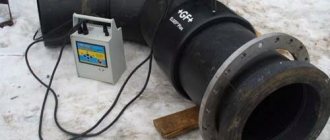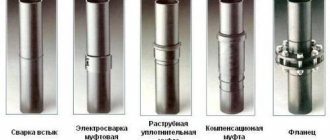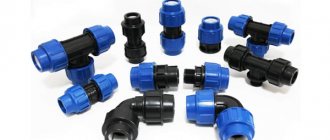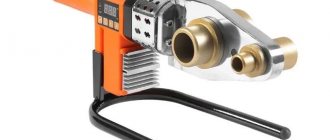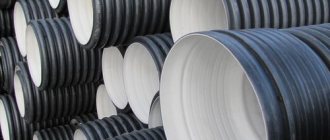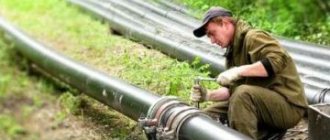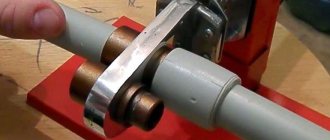Nowadays, PVC (polyvinyl chloride) and HDPE (low-density polyethylene) plastic pipes are very often used for laying pipelines in heating systems. This greatly simplifies the installation process and makes it accessible to the hands of a person who does not have professional skills. Here you don’t need to be a welder, use a grinder for cutting, etc.
Plastic solder ball valve
But if problems with pipes have not arisen for a long time, then questions regarding shut-off valves still exist. How to install taps in a system of plastic pipes and, most importantly, what taps to use? This is exactly what our article will discuss.
Characteristics and device
The technical characteristics of the part depend on the material from which it is made. Plastic fittings are made from PVC NP. Products made from this material can withstand high pressure better than classic PVC.
The PVC faucet has the following technical characteristics:
- The movement of the locking plate is 90 degrees.
- Possible diameters are from 10 to 65 mm and from 65 to 110 mm.
- Withstand pressure - up to 1.6 MPa.
Almost everyone knows how locking elements work, but not everyone knows their internal structure. The part consists of several elements:
- The body is made from a piece of plastic pipe, which expands in the central part.
- A locking element that has a spherical shape.
- Handle for controlling the position of the ball.
- Sealing gaskets.
- A seat located in the central part of the part.
The seat must be covered with a sealing layer to ensure reliable sealing.
Material for making valves
Here it is necessary to divide the valves into those that will be used in internal water supply networks, and those installed externally.
For internal networks, devices are made of bronze, brass, stainless steel and plastic. For exterior use models made from all of the above materials, as well as steel and cast iron.
- Devices made of brass and bronze are the most expensive, but at the same time the most durable. They have a low specific gravity, small dimensions, and can be installed on both cold and hot water pipes. More recently, they were the only ones used in the heating system, because scale does not settle on the surfaces of brass and bronze appliances.
- Stainless steel valves also boast a long service life. But they are an order of magnitude cheaper than the first two models.
- Plastic shut-off valves are the cheapest with good technical characteristics. Today it is used on all types of water supply and heating networks.
Attention! Stainless steel valves are not recommended for installation in hot water supply and heating systems. On their surface, under the influence of hot water, scale forms, which reduces the cross-section of the throughput channel.
Kinds
Plastic taps can be divided into separate groups according to different criteria. For example, according to their location in the system, two groups of parts are distinguished:
- End - installed at the ends of the water supply system, used to drain liquid from the system.
- Pass-through - installed on straight sections of pipes.
A separate division concerns the installation of the part. There are several types of fastenings that differ in design:
- The presence of internal threads, which are located in the connecting pipes.
- The design contains a coupling used for adhesive connection with other pipeline elements.
- Welded - such parts are fixed to the pipes using a special welding machine. This type of connection allows you to achieve a high level of tightness.
- Flange - a type of fastening that involves the use of non-separable, collapsible flanges. Used for pipes with a diameter of more than 50 mm.
According to the internal structure, two large groups of products are distinguished:
- Ball - can be detachable on one side or on both sides. This allows you to easily remove the tap if it breaks. There are angular and straight products.
- Valves - the peculiarity of such mechanisms is that they allow you to regulate the force of liquid flow in the water supply.
The choice of types of taps depends on the purpose of the part and the required technical characteristics. A separate design group concerns parts with additional functions. These can be various regulators, holes for bleeding air.
Plastic ball valve
Classification of water valves
This element of shut-off valves is classified according to various criteria.
- According to the type and design of the locking device.
- According to the material of manufacture.
- According to the method of connection to the pipe.
Type of locking device design
There are three positions here:
- Valve valve.
- Cork, also known as conical.
- Ball.
Valve valve
A valve valve, often called a valve tap, is a device body divided by a horizontal or inclined partition. The latter has a hole with a groove for the valve. This area is called the saddle.
The valve is the part of the stem that is located at the bottom. An elastic gasket is inserted into it, which rests against the saddle, thereby cutting off the water supply.
The rod itself has a thread at the top that fits into the thread of the seat nut. It is through the threaded connection that the valve is raised or lowered when the stem rotates.
| Advantages | Flaws |
| Valve taps can withstand high pressure. | The gasket wears out quickly because it comes into contact with metal at the bottom. |
| With their help you can regulate the volume and pressure of water. | Short service life compared to other types. |
| The controls are simple. | You have to rotate the rod for a long time to shut off or open the water. |
| Possibility of repairs. |
We recommend that you read: How to determine why a water tap is humming and eliminate the cause?
Conical
A cone-type water valve is a subtype of a valve device, because the design of the valve itself differs from the first one only in the valve. It is a cone-shaped plug, which, when the rod rotates, falls into the hole in the partition, closing it with itself.
All the pros and cons of a valve-type valve can also be attributed to cone models.
Ball
The device received its name due to the shape of the locking device. This is a ball in which a through slot (channel) is made. If the latter turns out to be perpendicular to the pipeline when the rod is turned, the water flow is blocked. Conversely, when the channel is located along the pipe, the valve is considered open.
| Advantages | Flaws |
| The simplicity of the opening and closing mechanism creates conditions for operating the valve for a very long time. | Can not be repaired. |
| Completely sealed structure. | According to the instructions, the ball valve should only be used as a locking device. You can regulate the water with it, but in this case, manufacturers do not guarantee long-term operation. |
| To close or open the water supply, you only need to turn the handle 90°. |
Advantages and disadvantages
Plastic taps have a number of strengths and weaknesses that you need to familiarize yourself with before purchasing. Advantages:
- Durability, reliability.
- Resistant to rust formation.
- Possibility of installation in polluted environments.
- You can quickly close or open a pipeline.
- Installation can be performed by anyone without additional skills.
- Plastic can withstand prolonged exposure to ultraviolet rays.
- The part can be operated at temperatures down to -15 degrees Celsius.
- Modern models are equipped with electric and pneumatic drives.
- High level of tightness.
- Simple design.
Flaws:
- For pipelines with a diameter of 110 mm, steel must be used due to its high strength index.
- Plastic elements do not have sufficient sealing for gas pipelines.
- Withstands a maximum temperature of about 66 degrees.
- At high temperatures they cannot withstand high pressure.
The small number of disadvantages indicates the relevance of using plastic parts for pipelines.
Rules for installation and operation of the crane
To install a faucet for plastic pipes, you need to prepare tools and perform work in a certain order. To complete the work you will need:
- rags;
- adhesive composition for plastic;
- tap;
- pipes.
Step-by-step instructions for carrying out the work:
- Two pipes need to be secured opposite each other. The distance between them must correspond to the length of the tap.
- Tighten the union nuts. Usually a handle to control the part is suitable for this. Screw them onto the sides of the pipes to be connected.
- Apply the selected adhesive composition to the areas to be joined as indicated on the adhesive instructions.
- Place the faucet on two pipes and secure it with union nuts.
- Remove the handle, remove the special insert that is located on the top of the handle. After this, turn the handle over and install it on the rod.
It is important to ensure that the water supply has check valves. They will protect the part from pressure drops, overheating, and water hammer.
Preparation for installation of a plastic tap
Frequent errors and problems during installation
The main mistake when assembling a water supply system is the uneven installation of individual plastic pipes relative to each other. The resulting distortion will spoil the strength of the finished connection and will quickly break during active use. After cutting the pipes, you need to check the cuts. They should be smooth, without protruding irregularities. Problems often arise when connecting the mixer. In this case, it is necessary to accurately calculate the pipe connections and their connections to the taps. Check the integrity of the pipeline after work.
Expert advice
Experienced installers give some tips that will help you carry out the installation yourself without encountering many problems:
- Do not forget to clean the joints from dirt and dust. Degrease it with alcohol.
- Choose an adhesive composition that is resistant to prolonged exposure to moisture.
- Install a special mesh filter in front of the tap.
- Be sure to rotate the check ball at least once a month. If you don't do this, it will stick to the walls of the case.
- If a ball joint is used, it must not be used to regulate water flow. This will incapacitate him. Such mechanisms are intended only to completely block the flow of liquid.
Plastic pipelines are used to install irrigation systems or piping pools. To ensure that the price tag for such structures does not turn out to be too high, you need to draw your site on a sheet of paper, think about the location of pipes and taps so that there are as few pipeline elements as possible.
Plastic taps are suitable for the manufacture of water supply and central heating pipelines. Any person can perform installation after familiarizing himself with the work process in theory. Additionally, you should watch the training video and consult with experienced installers.
How to repair a valve
This applies to valve-type valves, in which the gasket most often fails. It must be replaced with a new one, and the device will continue to work without creating problems.
Attention! The valve can be repaired without removing it from the pipeline.
- To do this, you will need a gas or adjustable wrench, which must be used to unscrew the valve axle box.
- The gasket is tightened by the nut. It must be unscrewed using a wrench of the required number or pliers.
- Ready-made gaskets are sold in stores, but you can cut them from a piece of rubber with scissors to the size of the old one.
- A hole is made in the center of the new cuff for the threaded pin protruding from the valve.
- The gasket is put on the pin and tightened with a nut.
- While the valve is disassembled, it is recommended to clean its internal cavities with a knife. The same must be done with the internal planes of the crane axle box.
- A new sealing thread is wound onto the threads of the valve axle. Linen is better.
- The axle box crane is screwed into the body by hand and pressed with a gas wrench. Don't screw it in too hard to avoid stripping the thread.
We recommend that you read: Crab fastening - connection system for profile pipes



